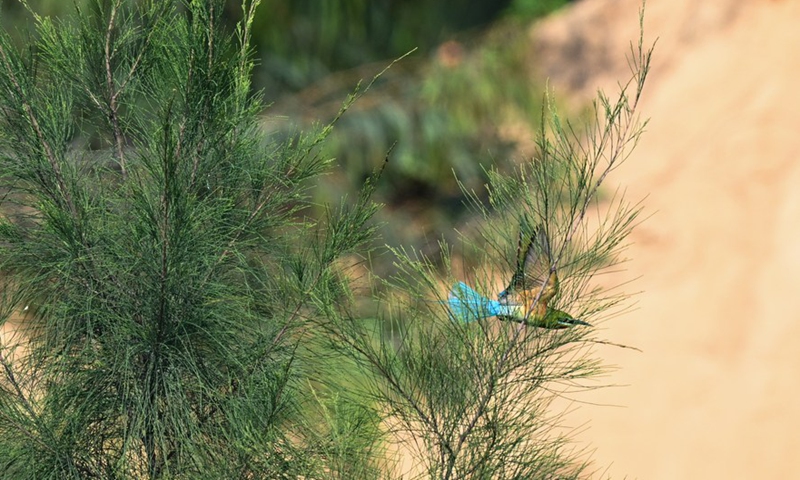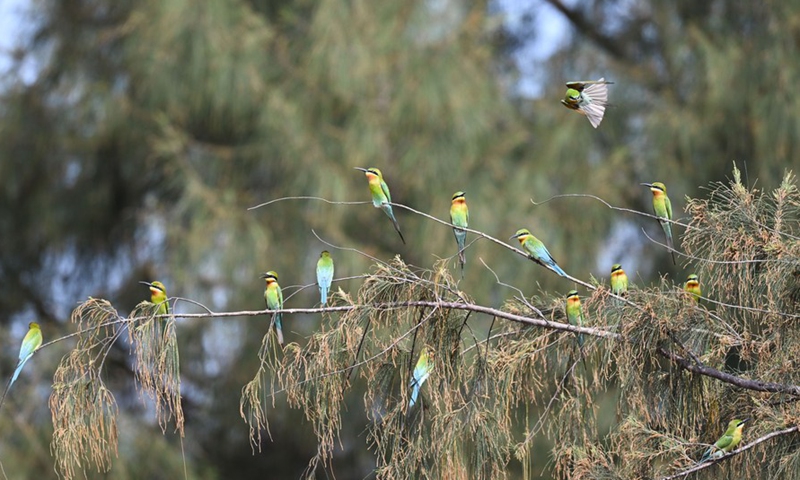
A blue-tailed bee eater is seen in Haikou, south China's Hainan Province, April 9, 2022.Photo:Xinhua

Blue-tailed bee eater is seen in Haikou, south China's Hainan Province, April 9, 2022.Photo:Xinhua
Chen Lei traveled all the way from northwest China to the southern Hainan Province just to catch a glimpse of blue-tailed bee-eaters and blue-throated bee-eaters nesting in a wetland park.
"I traveled more than 2,000 km from Ningxia Hui Autonomous Region to the tropical island province to observe the beautiful birds here in Haikou," said Chen, 44, referring to Hainan's provincial capital. "Environmental protection is important, and I see people from different walks of life are doing their part in this regard."
Bee-eaters are a richly-colored bird family. As their name suggests, they are known to hunt bees, in addition to wasps, and dragonflies. In Haikou, these birds are often found along the western coast. The blue-tailed bee-eaters are under state protection.
Each year, from April to June, the birds nest and reproduce at the Wuyuan River National Wetland Park in Haikou, a huge draw for many bird watchers.
On Thursday, a group of nature enthusiasts came to the park to observe the bee-eaters, dubbed "the most beautiful birds in China," and "feel the beauty of biodiversity in Hainan."
In Haikou, the birds were first spotted in 2018, about 300 meters from a government office building, said Lu Gang, head of the Duotan wetland research institute.
"On that occasion, we saw more than 20 birds nesting near the park," Lu said.
Over the past few years, the number of bee-eaters has increased from 28 to 80 by early May, according to the latest monitoring figures.
Haikou authorities started building the wetland park in 2017, it was later given national park status. In 2019, the city launched a project to protect the bee-eaters, and Lu's institute started working to "build a good surviving environment for the birds," and improve bird monitoring.
"If the bee-eaters are thriving in a city, it means that the local wetland system is good," Lu added. "It also shows that the city pays great attention to the environment." TAKING BEE-EATERS UNDER WING
To enhance wetland protection, Lu's institute hired two patrollers. One of them is Chen Chuanglin.
Chen, 40, previously worked for the agriculture and rural affairs bureau of Xiuying, a district in Haikou. Years of forest patrolling work honed his skills to "identify bird species by their song."
"I began working for the Wuyuan River environment protection project in December 2019," Chen said.
Besides his daily patrols, Chen also helps monitor birds in other areas in Haikou.
"I learned from horticulturalists how to differentiate plants, and I taught myself how to install infrared cameras," he said, adding that he also uses cameras to record animals and plants in his patrol areas.
"As a good patroller, you need to understand the characteristics and functions of a forest when you see it," he said. "You need to be able to tell the types and habits of birds when you see them."
Chen is now a major force in bee-eater monitoring.
"After getting involved in bird protection, I realized that Mother Nature has a lot of hidden secrets," Chen said. "I learned that people, the trees, the birds and the nature environment are all inter-connected."
